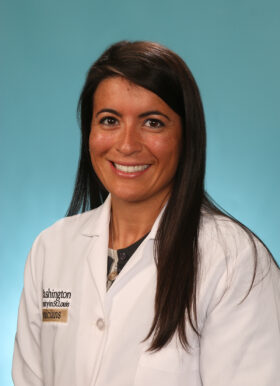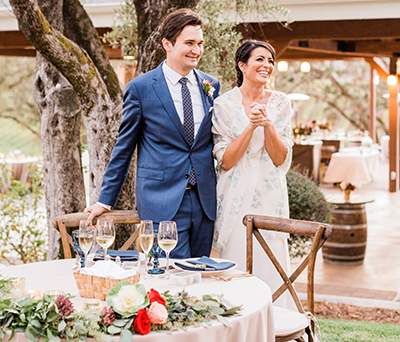Emily Spataro, MD

Emily Spataro, MD, is a surgeon in the Department of Otolaryngology who specializes in facial plastic and reconstructive surgery, which includes rhinoplasty (nasal reconstructive or cosmetic surgery), other cosmetic surgeries and procedures for facial rejuvenation and aging, facial Mohs reconstruction, and facial trauma.
Please call 314-996-3880 or 314-362-7509 for an appointment.
What happened in the course of schooling to influence you to choose your specialty?
I started as a biomedical engineering major, and through this training, I conducted research in the operating room and was able to observe a breast oncology surgeon. It was inspiring to work with her and see how she was able to help people every day. That experience started me along the path to medical school, and then to surgery. From there it was a matter of deciding which surgical subspecialty was the best fit for me. My other interests in life have always included art, graphic design, painting and interior decorating. Facial plastic surgery was a way to bridge this visual aspect of my personality with medicine.
What brought you to Washington University?
I’m from St. Louis, so I knew Washington University’s reputation as a great medical center. I took a year between college and medical school and did oncology research in the lab here. That experience made me realize that this is where I wanted to go to medical school. After my residency here and my fellowship at Stanford University, I knew I wanted to return and be a part of the Washington University and St. Louis community.
How did you decide to pursue facial plastic surgery?
Once in medical school, I sought to explore all different interests and options. I spent time shadowing with a vascular surgeon, trauma surgeon, and observed some orthopedic procedures as well. In choosing my third year surgical clerkships, I wanted to choose specialties combining my interest in design and visual arts with medicine, so I was able to choose rotations including plastic surgery as well as otolaryngology—head and neck surgery. I ultimately chose otolaryngology—head and neck surgery as a path to facial plastic surgery as my specialty during my 3rd year of medical school.
Not only does this field expose you to the subspecialty of facial plastic surgery, but every procedure we do, whether head and neck oncology surgery, otology, laryngology, etc, provides vast knowledge and familiarity with the very complex anatomy of the head and neck. I think this training is essential in fully understanding the procedures we do in facial plastic surgery.

Which aspect of your practice is most interesting?
This entire subspecialty of facial plastic surgery is a very interesting and diverse field. My day can begin with skin cancer reconstruction surgery and end with performing a face lift.
Because it is incredibly complex, the most interesting surgery I perform is rhinoplasty. It can be done for both function and cosmetic reasons — and those often go hand-in-hand.
If you have difficulty breathing through your nose, you want it to function well and still look good. Bridging those two with very small changes in the nose can have a very big impact for an individual because it is one of the major structures on the face that others see right away.
Being able to understand the complexities of this procedure and have success from both a functional and cosmetic aspect is challenging and rewarding. My training at Washington University, as well as my facial plastic fellowship training at Stanford University, were particularly strong in complex primary and revision rhinoplasty for both cosmetic and functional purposes, and I carry this forward to my practice today.
What are some of the new developments in your field that you are most excited about?
In this field, there are always new technologies emerging because it is a very consumer-driven industry. Developments include new products and techniques for rejuvenation and anti-aging that are less invasive – resulting in shorter downtime. I am very involved in facial plastic surgery research, as well as the American Academy of Facial Plastic Surgery to stay informed about this continually changing and advancing field to provide patients with not only new treatments, but those that are supported by research.
Are there any advances in the rhinoplasty field?
The field of rhinoplasty is constantly evolving. During the 1980s, the trend was “the smaller the better.” Celebrities wanted smaller noses, which involved removing a lot of cartilage – sometimes resulting in a non-functional and non-structurally sound nose. Then it shifted to “we took too much away, let’s add some cartilage back.” Now we look at the individual’s anatomy and enhance it, rather than make really large changes – always keeping in mind the functional aspect. This change in philosophy translates to how we can best balance the changes a person wants from a cosmetic standpoint, but also requires for a structurally sound and functional nose.
How do you take what a patient wants and translate it into real life?
The patients are part of the process. The first step is to take photos of the patient to help define expectations. I’ll use their photos and manipulate the images with Photoshop. I’ll explain “this is how your nose looks now, and small changes will be made to enhance the features you have – it won’t ever be someone else’s nose.”
There is back and forth conversation with the patient to ensure his or her expectations are in line with what can be accomplished surgically. Making very small changes on the nose can go a long way in changing someone’s appearance.
What are the challenges with revision rhinoplasty surgery?
Revision rhinoplasty surgeries are definitely more challenging because you don’t always know exactly what has been done to the underlying structure of the nose in the previous surgery, and whether enough cartilage exists to achieve the desired outcome.
Oftentimes cartilage from the nose (septum) will be used during the first surgery to treat either a functional issue with the nose or to aid in the cosmetic change. During the revision, not enough cartilage may remain to make the changes needed, so cartilage may need to be harvested from the ear or rib. This allows structural changes to the nose, which will help a patient breathe better and maintain both the cosmetic and functional results for a long period of time.
My advice for someone seeking revision rhinoplasty is to see a surgeon with specialized training in revision rhinoplasty, because it is a very complex procedure.
Where are you from?
I’m from St. Louis – I grew up here, and went to high school at Cor Jesu Academy. I went to Duke University for my undergraduate degree and returned to St. Louis for most of my medical training (Washington University and Barnes-Jewish Hospital). My fellowship was at Stanford University. While California was very nice, I am glad to be back in St. Louis, where I now live with my husband, who does otology surgery, and most of my friends and family are still here.
Which particular award or achievement is most gratifying?
I am very proud of the course of events that brought me here. My goal was always to achieve a position in the field of academic facial plastic medicine – and very few of these positions are offered each year.
My fellowship at Stanford gave me the opportunity to perform many rhinoplasties and aging face surgeries. It was a lot of hard work, but that experience gave me the skill set to bring me back here to Washington University. It was not one particular award but everything that led me in the right direction — I feel very fortunate.
What do you enjoy about academic medicine?
Teaching and tutoring are very important to me. I knew I wanted to work in an academic community as a mentor for medical students, residents, and fellows. It is essential to have a work/life balance, and that is not easy to accomplish, especially for women. I enjoy being able to guide women who have decided to go into this field.
Also, the research aspect in an academic environment gives me an opportunity to have a wider reach and contribute to advances and improvements in the field.
What is the best advice you’ve received?
It is not necessarily advice, as much as mentorship, and those that have led by their example. Many people have inspired me along the way, in particular my mentors in facial plastic surgery at both Washington University and Stanford University, but one of my main inspirations is my mom. She went to dental school at Washington University, and also taught at Washington University School of Dentistry. She owns her dental practice in Clayton, and I’ve seen how she has built her practice, but always keeps her patients’ needs first. Her patients know they can always call her – after hours, weekends—and she will answer. Their care comes first, not the bottom line.
I use my mom as an example of how I want to treat my patients. I want my patients to know I am always accessible and want to provide the best care for them as an individual. I find it fulfilling to build longstanding relationships with them – not just treat them for one moment in time, as sometimes is the case in surgical practices.
If you weren’t a doctor, what would you like to be doing?
That’s an easy question — I love interior design. My husband and I have done several renovation projects. In my spare time, I’m redecorating, creating art for my parents and friends, and doing my own projects. It is a visual hobby that merges into what I do as a facial plastic surgeon – using spatial relationships to determine how things look best together.